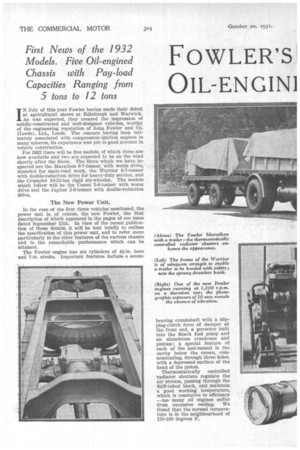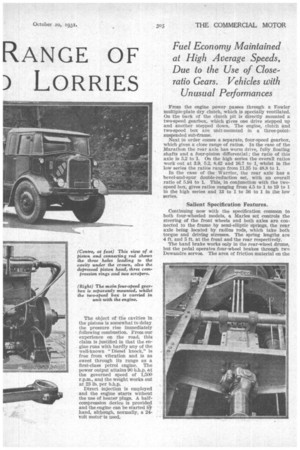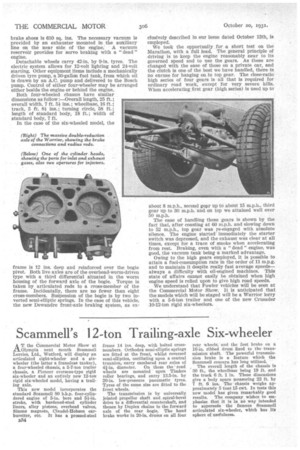FOWLER'S OIL-ENGIN1 RANGE OF ) LORRIES
Page 50

Page 51

Page 52

If you've noticed an error in this article please click here to report it so we can fix it.
IN July of this year Fowler lorries made their debut at agricultural shows at Edinburgh and Warwick. As was expected, they created the impression of solidly-constructed and well-designed vehicles, worthy of the engineering reputation of John Fowler and Co. (Leeds), Ltd., Leeds. The concern having been intimately associated with compression-ignition engines in many spheres, its experience was put to good account in
vehicle construction. _
For 192 there will be five models, of which three are now available and two are expected to be on the road shortly after the Show. The three which we have inspected are the Marathon 6-7-tonner, with worm drive, intended for main-road work, the Warrior 6-7-tonner with double-reduction drive for heavy-duty service, and the Crusader 1042-ton rigid six-wheeler. The models which follow will be the Comet 5-6-tonner with worm drive and the Jupiter 5-6-tonner with double-reduction drive, The New Power Unit.
In the case of the first three vehicles mentioned, the Power unit is, of course, the new Fowler, the first description of which appeared in the pages of our issue dated September 15th. In view of the recent publication of these details, it will be best briefly to outline the specification of this power unit, and to refer more particularly to the other features of the various chassis and to the remarkable performance which can be attained.
The Fowler engine has six cylinders of 41-in, bore and 7-in. stroke. Important features include a seven bearing crankshaft with a slipping-clutch form of damper at the front end, a governor built into the Bosch fuel pump and an aluminium crankcase and pistons; a special feature of each of the last-named is the cavity below the crown, communicating, through three holes, with a depressed surface of the head of the piston.
Thermostatically controlled radiator shutters regulate the air stream, passing through the Still-tubed block, and maintain a good working temperature, which is conducive to efficiency —too many oil engines suffer from excessive cooling. We found that the normal temperature is in the neighbourhood of 150-160 degrees F.
The object of the cavities in the pistons is somewhat to delay the pressure rise immediately following combustion. From our experience on the road, this claim is justified in that the engine runs with hardly any of the well-known "Diesel knock," is free from vibration and is as sweet through its range as a first-class petrol engine. The power output attains 90 b.h.p. at the governed speed of 1,500 r.p.m., and the weight works out at 23 lb. per b.h.p.
Direct injection is employed and the engine starts without the use of heater plugs. A halfcompression device is provided and the engine can be started b.s, hand, although, normally, a 24volt motor is used.
From the engine power passes through a Fowler multiple-plate dry clutch, which is specially ventilated. On the back of the clutch pit is directly mounted a two-speed gearbox, which gives one drive stepped up and another stepped down. The engine, clutch and two-speed box are unit-mounted in a three-pointsuspended sub-frame.
Next in order comes a separate, four-speed gearbox, which gives a close range of ratios. In the ease of the Marathon the rear axle has worm drive., fully floating shafts and a four-pinion differential ; the ratio of this axle is 5.2 to I. On the high series the overall ratios work out at 3.9, 5.2, 8.42 and 16.7 to 1, whilst in the low series the ratios range from 11.35 to 48.8 to 1.
In the case of the Warrior, the rear axle has a bevel-and-spur double-reduction set, with an overall ratio of 5.94 to 1. This, in conjunction with the twospeed box, gives ratios ranging from 4.5 to 1 to 19 to 1. in the high series and 13 to 1 to 56 to 1 in the low series.
Salient Specification Features.
Continuing now with the specification common to both four-wheeled models, a Manes set controls the steering of the front wheels and both axles are connected to the frame by semi-elliptic springs, the rear axle being located by radius rods, which take both torque and driving stresses. The spring lengths are 4 ft. and 5 ft, at the front and the rear respectively.
The hand brake works only in the rear-wheel drums, but the pedal operates four-wheel brakes through two Dewandre servos. The area of friction material on the brake shoes is 610 sq. ins. The necessary vacuum is provided by an exhauster mounted in the autiliary line on the near side of the engine. A vacuum reservoir provides for servo braking with a " dead " engine.
Detachable wheels carry 42-in. by 9-in. tyres. The electric system allows for 12-volt lighting and 24-volt starting. Other equipment items include a mechanically driven tyre pump, a 30-gallon fuel tank, from which oil is drawn by an A.C. pump and delivered to the Bosch pump. Control of either four-wheeler may be arranged either beside the engine or behind the engine.
Both four-wheeled chassis have similar dimensions as follow :—Overall length, 25 ft.; overall width, 7 ft. 5i ins.; wheelbase, 16 ft.; track, 5 ft. 8i ins.; turning circle, 58 ft.; length of standard body, 18 ft.; width of standard body, 7 ft.
In the case of the six-wheeled model, the
frame is 12 ins, deep and reinforced over the bogie pivot. Both live axles are of the overhead-worm-driven type with a third differential situated in the worm housing of the forward axle of the bogie. Torque is taken by articulated rods to a cross-member of the frame. Incidentally, there are no fewer than eight cross-members. Suspension of the bogie is by two inverted semi-elliptic springs. In the case of this vehicle, the new Dewandre front-axle braking system, as ex
elusively described in our issue dated October 13th, is employed. We took the opportunity for a short test on the Marathon, with a full load. The general principle of driving is to keep the engine reasonably near to its governed speed and to use the gears. As these are changed with the ease of those on a private car, and the clutch is one of the best we have handled, there is no excuse for hanging on to top gear. The close-ratio high series of four gears is all that is required for ordinary road work, except for very severe hills. When accelerating first gear (high series) is used up to about 8 m.p.h., second gear up to about 15 m.p.h., third gear up to 30 m.p.h. and on top we attained well over 50 m.p.h.
The ease of handling these gears is shown by the fact that, after coasting at 60 m.p.h. and slowing down to 52 m.p.h., top gear was re-engaged with absolute silence. The engine started immediately the starter switch was depressed, and the exhaust was clear at all times, except for a trace of smoke when accelerating from rest. Braking, even with a " dead " engine, was good, the vacuum tank being a marked advantage.
Owing to the high gears employed, it is possible to attain a fuel-consumption rate in the order of 11 m.p.g. and to maintain it despite really fast average speeds— always a difficulty with oil-engined machines. This state of affairs cannot easily be obtained when high engine speed is relied upon to give high road speeds.
We understand that Fowler vehicles will be seen at the Commercial Motor Show. It is anticipated that the models which will be staged will be a Warrior lorry with a 5-6-ton trailer and one of the new Crusader 10-12-ton rigid six-wheelers.




































































































